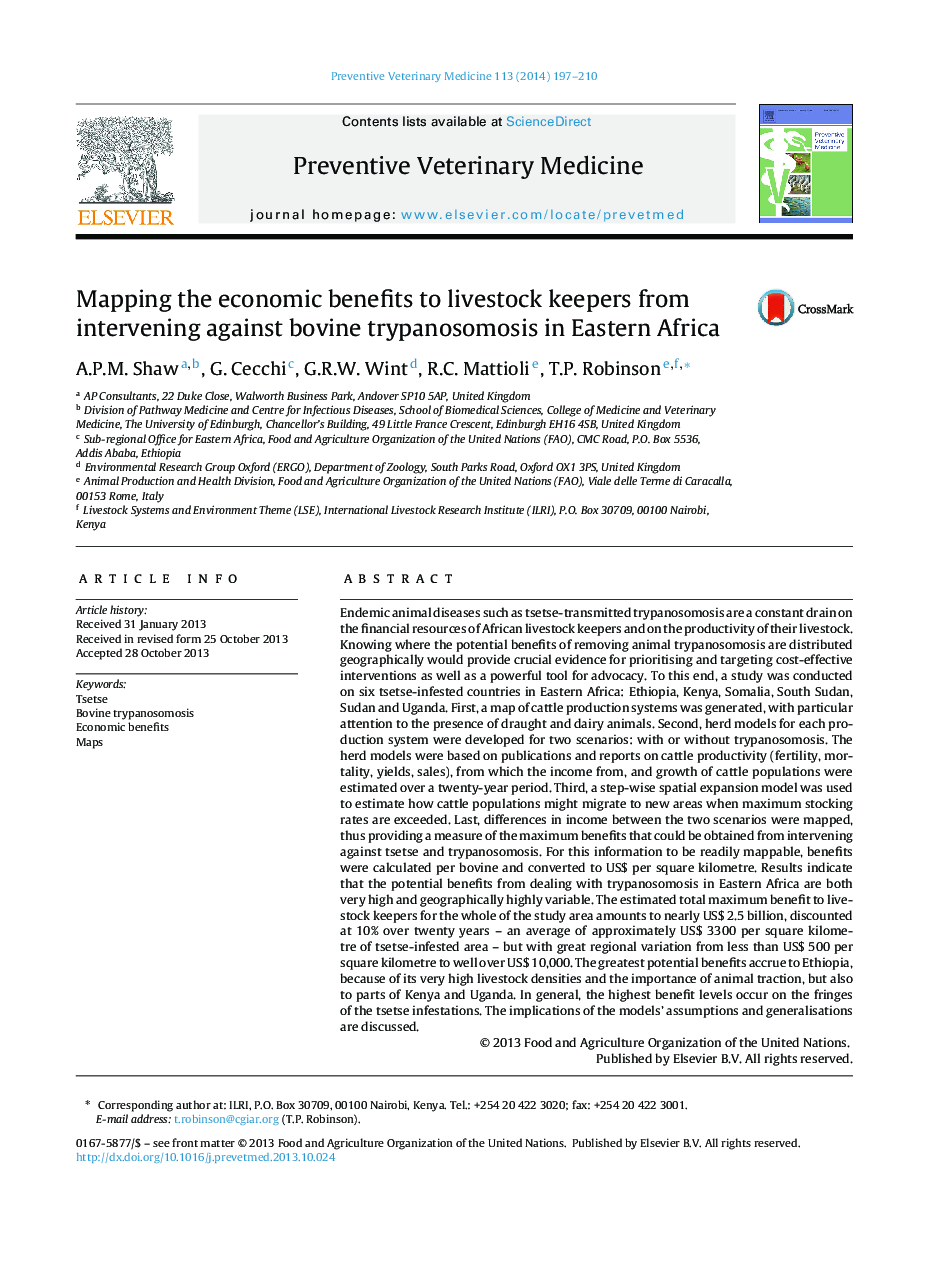| کد مقاله | کد نشریه | سال انتشار | مقاله انگلیسی | نسخه تمام متن |
|---|---|---|---|---|
| 5793601 | 1110022 | 2014 | 14 صفحه PDF | دانلود رایگان |
عنوان انگلیسی مقاله ISI
Mapping the economic benefits to livestock keepers from intervening against bovine trypanosomosis in Eastern Africa
ترجمه فارسی عنوان
ارزیابی مزایای اقتصادی دامداران از دخالت در تریپانوسوموز گاو در شرق آفریقا
دانلود مقاله + سفارش ترجمه
دانلود مقاله ISI انگلیسی
رایگان برای ایرانیان
کلمات کلیدی
تسه تریپانوسوموز گاو، مزایای اقتصادی، نقشه ها،
ترجمه چکیده
بیماری های حیوانی اندامی مانند تریپانوسوموز انتقال یافته به سلول تسنس، صرفه جویی مداوم در منابع مالی دامداران آفریقایی و بهره وری دام آنها است. دانستن اینکه در آن مزایای بالقوه حذف تریپانوسوموز حیوانات از لحاظ جغرافیایی توزیع می شود، شواهد مهمی برای اولویت بندی و هدف گیری مداخلات با هزینه ای موثر و همچنین یک ابزار قدرتمند برای حمایت می کنند. برای این منظور، یک مطالعه بر روی 6 کشور آلوده به تتسه در شرق آفریقا انجام شد: اتیوپی، کنیا، سومالی، سودان جنوبی، سودان و اوگاندا. ابتدا یک نقشه سیستم تولید گاوها با توجه به حضور حیوانات پیش رونده و لبنیات تولید شد. دوم، مدل های گله برای هر سیستم تولید برای دو سناریو با تریپانوسوموز یا بدون آن توسعه یافت. مدل های گله براساس نشریات و گزارشات مربوط به بهره وری گاو (باروری، مرگ و میر، عملکرد، فروش)، که درآمد حاصل از آن و رشد جمعیت گاوها طی یک دوره بیست ساله تخمین زده شد. سوم، یک مدل توسعه فضایی گام به گام برای برآورد اینکه چگونه جمعیت های گاو ممکن است به مناطق جدید مهاجرت کنند، زمانی که حداکثر میزان گاو بودن بیش از حد است استفاده شود. در آخر، تفاوت درآمد بین دو سناریو نقشه بندی شده بود، بنابراین اندازه گیری حداکثر مزایایی را که می توان از مداخلات علیه مخچه و تریپانوسوموز بدست آورد، فراهم می کند. برای این اطلاعات به راحتی قابل نقشه برداری، مزایای بر اساس گاو محاسبه و تبدیل به دلار آمریکا در هر کیلومتر مربع است. نتایج نشان می دهد که مزایای بالقوه از برخورد با تریپانوسوموز در آفریقای شرقی بسیار متغیر هستند و از لحاظ جغرافیایی بسیار متغیر هستند. برآورد حداکثر مزایای کل دامداران در کل منطقه مورد مطالعه تقریبا 2.5 میلیارد دلار است که بیش از بیست سال به میزان 10 درصد تخفیف - به طور متوسط حدود 3300 دلار آمریکا در هر کیلومتر مربع از منطقه تست مزمن - اما با بزرگ تنوع منطقه ای از کمتر از 500 دلار در هر کیلومتر مربع به بیش از 10،000 دلار آمریکا. بیشترین مزایای بالقوه ایالت اتیوپی به علت تراکم بالای حیوانات و اهمیت کشش حیوانات، بلکه به بخشی از کنیا و اوگاندا نیز مربوط می شود. به طور کلی، بالاترین سطح سود در نقاط آلودگی تست وجود دارد. مفاهیم مفروضات و تعمیم های مدل مورد بحث قرار گرفته است.
موضوعات مرتبط
علوم زیستی و بیوفناوری
علوم کشاورزی و بیولوژیک
علوم دامی و جانورشناسی
چکیده انگلیسی
Endemic animal diseases such as tsetse-transmitted trypanosomosis are a constant drain on the financial resources of African livestock keepers and on the productivity of their livestock. Knowing where the potential benefits of removing animal trypanosomosis are distributed geographically would provide crucial evidence for prioritising and targeting cost-effective interventions as well as a powerful tool for advocacy. To this end, a study was conducted on six tsetse-infested countries in Eastern Africa: Ethiopia, Kenya, Somalia, South Sudan, Sudan and Uganda. First, a map of cattle production systems was generated, with particular attention to the presence of draught and dairy animals. Second, herd models for each production system were developed for two scenarios: with or without trypanosomosis. The herd models were based on publications and reports on cattle productivity (fertility, mortality, yields, sales), from which the income from, and growth of cattle populations were estimated over a twenty-year period. Third, a step-wise spatial expansion model was used to estimate how cattle populations might migrate to new areas when maximum stocking rates are exceeded. Last, differences in income between the two scenarios were mapped, thus providing a measure of the maximum benefits that could be obtained from intervening against tsetse and trypanosomosis. For this information to be readily mappable, benefits were calculated per bovine and converted to US$ per square kilometre. Results indicate that the potential benefits from dealing with trypanosomosis in Eastern Africa are both very high and geographically highly variable. The estimated total maximum benefit to livestock keepers for the whole of the study area amounts to nearly US$ 2.5 billion, discounted at 10% over twenty years - an average of approximately US$ 3300 per square kilometre of tsetse-infested area - but with great regional variation from less than US$ 500 per square kilometre to well over US$ 10,000. The greatest potential benefits accrue to Ethiopia, because of its very high livestock densities and the importance of animal traction, but also to parts of Kenya and Uganda. In general, the highest benefit levels occur on the fringes of the tsetse infestations. The implications of the models' assumptions and generalisations are discussed.
ناشر
Database: Elsevier - ScienceDirect (ساینس دایرکت)
Journal: Preventive Veterinary Medicine - Volume 113, Issue 2, 1 February 2014, Pages 197-210
Journal: Preventive Veterinary Medicine - Volume 113, Issue 2, 1 February 2014, Pages 197-210
نویسندگان
A.P.M. Shaw, G. Cecchi, G.R.W. Wint, R.C. Mattioli, T.P. Robinson,
